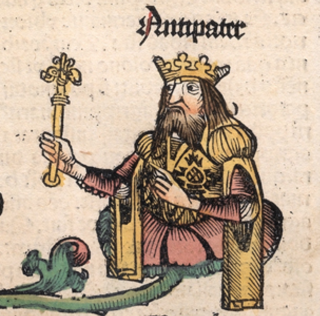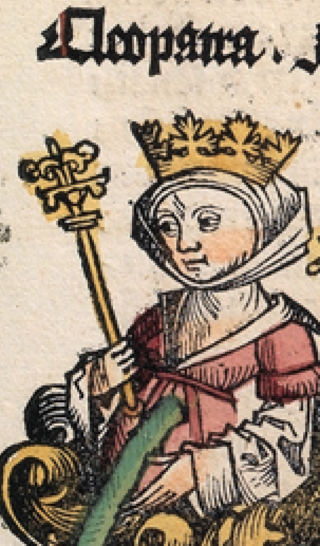Berenice was the daughter of Mariamne, daughter of Herod Agrippa, and Gaius Julius Archelaus Antiochus Epiphanes, [1] son of Chelcias (maybe Hilkiya in Hebrew, who was a friend and an officer at the court). [2] She was born sometime after 50 CE. After her parents had divorced, she lived with her mother in Alexandria. [3]

Flavius Josephus or Yosef ben Mattityahu was a Roman–Jewish historian and military leader. Best known for writing The Jewish War, he was born in Jerusalem—then part of the Roman province of Judea—to a father of priestly descent and a mother who claimed royal ancestry.

Berenice of Cilicia, also known as Julia Berenice and sometimes spelled Bernice, was a Jewish client queen of the Roman Empire during the second half of the 1st century. Berenice was a member of the Herodian Dynasty that ruled the Roman province of Judaea between 39 BC and 92 AD. She was the daughter of King Herod Agrippa I and Cypros and a sister of King Herod Agrippa II.
The Sadducees were a sect of Jews active in Judea during the Second Temple period, from the second century BCE to the destruction of the Second Temple in 70 CE. The Sadducees are described in contemporary literary sources in contrast to the two other major sects at the time, the Pharisees and the Essenes.

Salome, also known as Salome III, was a Jewish princess, the daughter of Herod II and princess Herodias. She was granddaughter of Herod the Great and stepdaughter of Herod Antipas. She is known from the New Testament, where she is not named, and from an account by Josephus. In the New Testament, the stepdaughter of Herod Antipas demands and receives the head of John the Baptist. According to Josephus, she was first married to her uncle Philip the Tetrarch, after whose death in AD 34 she married her cousin Aristobulus of Chalcis, thus becoming queen of Armenia Minor.

Herodias was a princess of the Herodian dynasty of Judaea during the time of the Roman Empire. Christian writings connect her with the execution of John the Baptist.

Herod Antipas was a 1st-century ruler of Galilee and Perea. He bore the title of tetrarch and is referred to as both "Herod the Tetrarch" and "King Herod" in the New Testament. He was a son of Herod the Great and a grandson of Antipater the Idumaean. He is widely known today for accounts in the New Testament of his role in events that led to the executions of John the Baptist and Jesus of Nazareth. His father, Herod the Great, was described in the account as ordering the Massacre of the Innocents, marking the earliest Biblical account of the concerns of the government in Jerusalem regarding Jesus' existence.

Salome Alexandra, or Shlomtzion, was a regnant queen of Judaea, one of only three women in Jewish historical tradition to rule over the country, the other two being Deborah and Athaliah. The wife of Aristobulus I, and afterward of Alexander Jannaeus, she was also the last ruler of Judaea to die as the sovereign of an independent kingdom. Her nine-year reign has been described as a "golden age" of Hasmonean history.

Herod Archelaus was the ethnarch of Samaria, Judea, and Idumea, including the cities Caesarea and Jaffa, for nine years. He was the son of Herod the Great and Malthace the Samaritan, brother of Herod Antipas, and half-brother of Herod II. Archelaus came to power after the death of his father Herod the Great in 4 BC, and ruled over one-half of the territorial dominion of his father. Archelaus was removed by the Roman emperor Augustus when Judaea province was formed under direct Roman rule, at the time of the Census of Quirinius.

Aretas IV Philopatris was the King of the Nabataeans from roughly 9 BC to 40 AD.

Julia Drusilla was a daughter of Herod Agrippa and Cypros. Her siblings were Berenice, Mariamne, and Herod Agrippa II. Her son Agrippa was one of the few people known by name to have died in the eruption of Mount Vesuvius in 79 AD.

Mariamne I, also called Mariamne the Hasmonean, was a Hasmonean princess and the second wife of Herod the Great. Her parents, Alexandra Maccabeus and Alexander of Judaea, were cousins who both descended from Alexander Jannaeus. She was known for her great beauty, as was her brother Aristobulus III. Herod's fear of his Hasmonean rivals led him to execute all of the prominent members of the family, including Mariamne.
Mariamne II was the third wife of Herod the Great. She was the daughter of Simon Boethus the High Priest. Josephus recounts their wedding thus:
There was one Simon, a citizen of Jerusalem, the son of one Boethus, a citizen of Alexandria, and a priest of great note there; this man had a daughter, who was esteemed the most beautiful woman of that time; and when the people of Jerusalem began to speak much in her commendation, it happened that Herod was much affected with what was said of her; and when he saw the damsel, he was smitten with her beauty, yet did he entirely reject the thoughts of using his authority to abuse her, as believing, what was the truth, that by so doing he should be stigmatized for violence and tyranny; so he thought it best to take the damsel to wife. And while Simon was of a dignity too inferior to be allied to him, but still too considerable to be despised, he governed his inclinations after the most prudent manner, by augmenting the dignity of the family, and making them more honourable; so he immediately deprived Jesus, the son of Phabet, of the high priesthood, and conferred that dignity on Simon, and so joined in affinity with him [by marrying his daughter].

Salome I was the sister of Herod the Great and the mother of Berenice by her husband Costobarus, governor of Idumea. She was a nominal queen regnant of the toparchy of Iamnia, Azotus, Phasaelis from 4 BCE.

Antipater II was Herod the Great's first-born son, his only child by his first wife Doris. He was named after his paternal grandfather Antipater the Idumaean. He and his mother were exiled after Herod divorced her between 43 BC and 40 BC to marry Mariamne I. However, he was recalled following Mariamne's fall in 29 BC and in 13 BC Herod made him his first heir in his will. He retained this position even when Alexander and Aristobulus rose in the royal succession in 12 BC, and even became exclusive successor to the throne after their execution in 7 BC.
Artystone also known as Irtašduna in the Fortification tablets, was a Achaemenid princess, daughter of king Cyrus the Great, and sister of Cambyses II, Atossa and Smerdis. Along with Atossa and her niece Parmys, Artystone married king Darius I. It is argued that by marrying the female offspring of Cyrus, the founder of the empire, the new king aimed to prevent his rule from being contested, since Darius himself was not of royal blood.

Malthace was a Samaritan woman who lived in the latter half of the 1st century BC. She was one of the wives of Herod the Great and the mother by Herod of Herod Antipas, Archelaus, and a daughter, Olympias. She died in 4 BC at Rome, while her sons Archelaus and Antipas were disputing the will of their father before the emperor Augustus.
Shuah is the name of one of four minor Biblical figures. It is sometimes used as the name of a fifth. Their names are different in Hebrew, but they were all transliterated as "Shuah" in the King James Version.

Cleopatra of Jerusalem was a woman who lived in the 1st century BC during the Roman Empire. She was the fifth wife of King of Judea, Herod the Great.

Tharbis, according to Josephus, was a Cushite princess of the Kingdom of Kush, who married Moses prior to his marriage to Zipporah as told in the Book of Exodus.

Cypros (1st-century) was a queen consort of Judea. She was married to king Herod Agrippa.